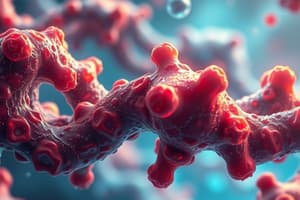Podcast
Questions and Answers
What is a catalyst?
What is a catalyst?
- A material that stops a chemical reaction but remains unchanged
- A material that speeds up a chemical reaction but remains unchanged (correct)
- A material that has no effect on a chemical reaction
- A material that slows down a chemical reaction and changes at the end
What are the two components of conjugated protein enzymes?
What are the two components of conjugated protein enzymes?
- Protein part and covalently attached part
- Protein part and substrate part
- Protein part and non-protein part (correct)
- Protein part and catalytic part
What is the function of the substrate binding site of an enzyme?
What is the function of the substrate binding site of an enzyme?
- It is the site where the enzyme carries out the chemical reaction
- It is the site where the product is released
- It is the site at which the substrate specifically binds (correct)
- It is the site where the enzyme is changed during the reaction
Which class of enzymes catalyzes oxidation-reduction reactions?
Which class of enzymes catalyzes oxidation-reduction reactions?
What are the three basic steps of enzyme-catalyzed reactions?
What are the three basic steps of enzyme-catalyzed reactions?
Flashcards are hidden until you start studying
Study Notes
Catalysts
- A catalyst is a substance that increases the rate of a chemical reaction without being consumed or altered in the process.
Components of Conjugated Protein Enzymes
- Conjugated protein enzymes consist of two components:
- Apoenzyme: The protein part, which is inactive on its own.
- Cofactor: A non-protein component, which can be a metal ion or an organic molecule (coenzyme) that is necessary for the enzyme's activity.
Substrate Binding Site
- The substrate binding site of an enzyme is the specific region where the substrate molecules bind.
- This site facilitates the formation of the enzyme-substrate complex, enabling the conversion of substrates into products.
Enzymes Catalyzing Oxidation-Reduction Reactions
- The class of enzymes that catalyzes oxidation-reduction reactions is known as oxidoreductases.
- These enzymes facilitate the transfer of electrons between molecules, altering their oxidation state.
Steps of Enzyme-Catalyzed Reactions
- The three basic steps of enzyme-catalyzed reactions include:
- Substrate Binding: The substrate binds to the enzyme at the active site.
- Formation of Enzyme-Substrate Complex: The enzyme undergoes a conformational change, stabilizing the transition state.
- Product Release: The products are released from the active site, and the enzyme returns to its original state to catalyze another reaction.
Studying That Suits You
Use AI to generate personalized quizzes and flashcards to suit your learning preferences.




